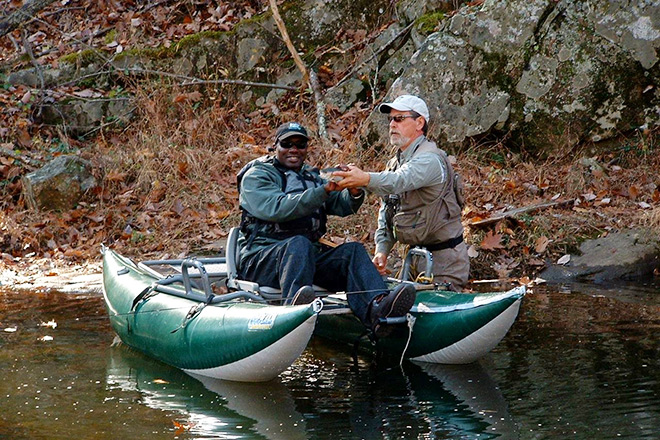Thanks to a group of dedicated volunteers, new trails are making national parks like Shenandoah more accessible.
“My definition of access is a little different from others’,” explains Mark Andrews, founder and executive director of Therapeutic Adventures, as we scramble down a bed of rocks along the Moormans River near Charlottesville, Virginia.
“We could get wheelchairs down this bank, maybe even people with prosthetics—folks with advanced prosthetics move around better than you and I can.”
Mark and I are standing on a muddy, flat streambed in the shadow of the Blue Ridge Mountains, right outside the entrance to Shenandoah National Park. In this remote fishing spot, the only sounds you’ll hear are the gentle ebbing of the river against the rocks or the occasional splash of a jumping speckled brook trout. An experienced fly angler, Mark can deftly find and point out each trout darting through the stretches of shallow water.
This isn’t your regular fishing spot, however. This path, known as the John Kostanecki Memorial Trail, is a project that provides adaptive access for hikers, anglers, and nature lovers with mobility issues who otherwise would not be able to enjoy Shenandoah’s pristine waters.
The volunteer-powered initiative, called “Paths to Happiness,” is a project of Therapeutic Adventures and the Thomas Jefferson chapter of Trout Unlimited. The volunteers in the program devoted more than 200 hours to grading, widening, and mulching the trail to make it easier for people with wheelchairs, Segways, walkers, and other assistive devices to use it. By providing this accessibility to a stretch of the river, the group has allowed new programs to connect people with special needs with parks—and reconnect wounded veterans with the activities they love, such as fly fishing and paddling.
Mark is a seasoned recreational therapist. Both he and “Chubby” Damron, president of the Thomas Jefferson Chapter of Trout Unlimited, have provided programs connecting wounded veterans and individuals with disabilities with national parks, from the mountains and streams of Shenandoah National Park to the salty waves of Assateague Island National Seashore. For more than three decades, this partnership has run an initiative called “Operation Freedom Outdoors” with adaptive outdoor programs in parks for thousands of returning Wounded Warriors and disabled veterans. Activities include everything from canoeing and climbing to skiing and snowboarding.
“We believe it’s imperative to support our soldiers and their families after they have returned home from military service. National parks are not only beautiful places to explore nature and recreate—they are places of healing,” says Andrews.
These volunteer programs are in-line with the National Park Service’s own goals to improve access for people of different abilities as the park system nears its centennial. The agency’s Accessibility Task Force has outlined a five-year strategy that includes embracing and incorporating accessible universal design principles for facilities, creating programs inclusive of people of varying abilities and their families, and upgrading existing facilities and services to improve the visitor experience.
Meanwhile, Mark and Chubby look forward to building new adaptive trails along the river. This past November, NPCA supported the Fly Fishing Festy, an event which provided lessons on adaptive fly fishing as well as therapeutic programs. This month, NPCA and its volunteers will join the effort to build accessible trails along the Moormans River, including the North Fork Moormans River Trail in Shenandoah National Park.
To learn more or get involved with Operation Freedom Outdoors, visit the Therapeutic Adventures website.
About the author
-
 Edward Stierli Senior Regional Director, Mid-Atlantic
Edward Stierli Senior Regional Director, Mid-AtlanticEd serves as Senior Director in the Mid-Atlantic region, overseeing NPCA’s activities in five states and the District of Columbia.
-
General
-
- Park:
- Shenandoah National Park
-
- NPCA Region:
- Mid-Atlantic
-
-
Issues




